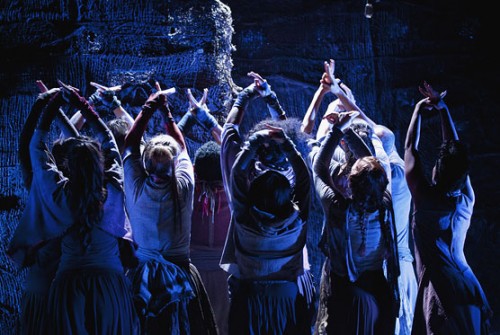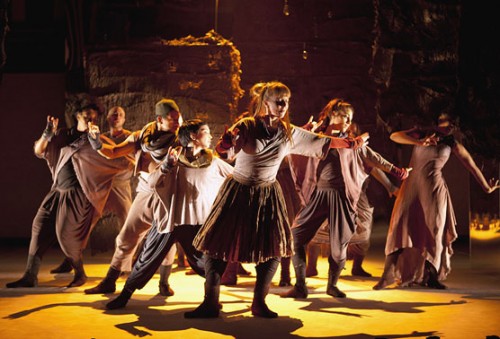How easy it is to drop out of the journey of self-discovery, with all the trials and temptations surrounding us. Yet how rewarding to stay the course. In the 1970s, a visionary director led his company through rural Africa, performing an adaptation of a 12th-century Persian poem about the birds of the world on a quest to find their king. The legacy of his artistic journey is best summed up by The Guardian‘s Michael Billington: “to reinforce the centrality of the shared experience, to clear the stage of clutter and to realise the need for ecstasy.”
His journey transformed theater.
However, I’m not sure how necessary it is to know anything about that director, Peter Brook, before seeing The Conference of the Birds, or even to know anything about the Sufi mystic who wrote the poem, Farid Uddi Attar, whom Rumi considered “the spirit.” Inside all of us is that same desire for total transcendence. Under the helm of director Aaron Posner, Folger Shakespeare Theatre’s production has a gentle, exquisite beauty that is as difficult and rewarding as that journey. It deserves more than one viewing, and will haunt the mind beyond.

The cast of Folger Shakespeare Theatre’s production of The Conference of the Birds. Photo credit: Scott Suchman.
The Conference of the Birds begins with a series of allegories told by the Hoopoe bird, as she (Patty Gallagher) urges an assembly of birds to start on a quest to find their king, the Simorgh. One by one, the birds’ excuses are swept aside by the Hoopoe’s teachings, whose guidance is typical guru: in order to be filled with enlightenment, you have to be emptied first. The birds will embark on a dangerous flight and lose everything they consider important along the way, until at last they are empty enough to be filled with the ultimate knowledge.
This is heady stuff, and Posner guides his cast perfectly. Through subtle avian physicality, accentuated by the fluttering drapes of Olivera Gajic’s costume design, the ensemble imbue their birds with distinct personalities. As individuals they are filled with doubts and fears; when they physically and vocally transform into a flock, the effect is truly powerful. Choreographer Erika Chong Shuch does beautiful work creating that otherworldly quality.
The ensemble’s commitment is total and they all deserve praise – Katie duBuys, Britt Duff, Jessica Frances Dukes, Jay Dunn, Robert Barry Fleming, Patty Gallagher, Tara Giordano, Celeste Jones, Jens Rasmussen, Annapurna Sriram, and Tiffany Rachelle Stewart. Above them in the rafters is Tom Teasley, weaving his always mesmerizing spell with live original music.
Part of the danger of producing a Brook-adapted play is that his theatrical style – spare set, strong physicality, group narrative – has been so imitated it’s in danger of losing its revolutionary quality. Posner avoids the traps by approaching the play with absolute sincerity. There’s an elegiac, elegant quiet to much of this production, punctuated by rousing moments of song, expressions of passionate vocality, and even humor. It all counterpoints well, and nothing is crammed in unnecessarily.
Witness the birds in the valley of love, where they elude each other, find each other, and disconnect again. Posner directs the pace to an achingly slow halt. This is a daring moment of potential alienation that puts the audience right in the center of both discomfort and beauty. He also chooses to accompany it with a completely different musical style than heard previously, heightening the surprise. As Sparrow, Britt Duff strums the ukelele and channels a poignant-voiced folk chanteuse, reminiscent of Jolie Holland perhaps. It’s an unexpected style to use, so delicate and intimate the air seems to still and time stops – just as it does for the birds themselves.
Many moments enrich this production. Just when you’re hypnotized by one, the mood suddenly shifts. A strutting peacock covers her deformed feet in shame. A man smears his face defiantly with his own blood, so as not to appear pale with fear. Moths flutter repeatedly into a flame. This isn’t an easy journey for a company or an audience to embark on. It’s beautiful yet challenging, and not everything will be clear.
But it doesn’t need to be.


